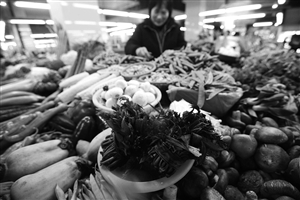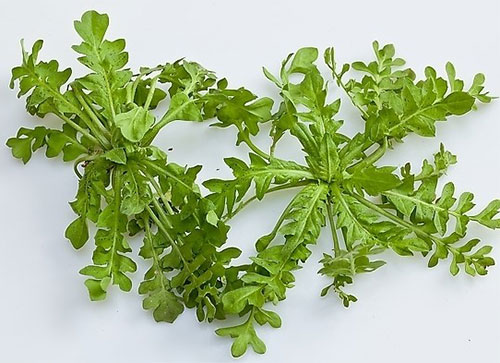The emergence of wild vegetable planting industry, the present situation and prospect of wild vegetable planting

Bracken
Shepherd's purse Photo Source: Baidu Picture
Wild vegetables are favored by growers and consumers at home and abroad because of their rapid growth, strong reproductive ability, rich nutrition, green and natural characteristics.
Hu Yingzi, a reporter from the ■ newspaper
In early spring and March, everything recovers. Wild vegetables are popular when they are tasted fresh in spring. In the vegetable market, wild vegetables are the darling of this season, although the price is much higher than ordinary vegetables, but it is still the freshness that many people scramble to buy.
The reporter learned that with the improvement of the utilization level of wild vegetable resources and the continuous expansion of market demand, wild vegetables have become a characteristic industry in many areas and are becoming a new agricultural industry in the ascendant.
Wild vegetables have a long history.
"take advantage of the south mountain and pick its ferns." "Wei picked Wei, Wei also stopped." "if the vegetables are of uneven length, the girl will pick them left and right." As we all know, these are the records of wild vegetables in the Book of songs.
Wild vegetables not only have high nutritional, medicinal and edible value, but also have strong resistance to diseases and insect pests, drought, moisture, high temperature, barren, saline and alkali tolerance and so on.
However, many wild vegetables that appear in the Book of songs have become people's daily vegetables. Take the bracken mentioned in the Book of songs as an example, this wild vegetable is widely distributed in the mountains and forests of most parts of China, and now it has become a common wild vegetable.
For a long time, people ate wild vegetables mainly by collecting wild resources. Nowadays, in order to meet the market demand, many wild vegetables have been cultivated artificially. Wild vegetables are favored by growers and consumers at home and abroad because of their rapid growth, strong reproductive ability, rich nutrition, green and natural characteristics.
In an agricultural trade products trading center in Beijing, the reporter saw that non-local wild vegetables such as Toona sinensis, Artemisia annua, Houttuynia cordata and other non-local wild vegetables have been listed and their prices are popular. Toona sinensis costs more than ten yuan every two, and Artemisia annua is sold for more than 20 yuan per jin.
Some industry experts said that most of the wild vegetables sold in the market are artificially planted, and natural wild vegetables are generally self-sufficient. The cultivated wild vegetables are well managed and have enough water, so they grow vigorously and have luxuriant branches, while the wild ones are relatively poor, but they are not absolute.
The rise of wild vegetable cultivation
Ten years ago, Li Pengfei, a native of Zhangjiakou, Hebei Province, first tried to grow wild dandelions. Dandelion is not only a medicine, but also a delicious wild vegetable. "Wild dandelions have strong vitality and grow fast, and they can be harvested in 20 to 25 days." Li Pengfei told China Science Daily.
This year he planted 40 mu of dandelion and planted wild vegetables such as scallions and wild garlic in the field. In addition to selling fresh wild vegetables, he also processes the harvested wild vegetables into quick-frozen wild vegetables and wild vegetable dumplings, which are distributed to catering enterprises.
Now, many people, like Lee Pengfei, are engaged in the cultivation of wild vegetables. Because wild vegetables have strong adaptability to environment and climate, and have strong resistance to diseases and insect pests, the application amount of chemical fertilizers and pesticides is very small, which has the advantages of low investment, low risk and good benefit.
Not only are individual farmers aiming at the cultivation and cultivation of wild vegetables, some areas with rich wild vegetable resources are also making great efforts to build the wild vegetable industry.
For example, Changzhi County, Shanxi Province, only produces 7.2 million kilograms of dandelion annually, with an annual output value of more than 6 million yuan. In the policy-driven, leading-driven, science and technology-driven, service-driven, the county presents a good situation of industry-driven economic development.
In theory, today's vegetables used to be wild vegetables, but now the so-called wild vegetables, after domestication, may also become the daily table. Some domesticated wild vegetables are different from pure wild vegetables. for example, wild dandelions generally have only five or six leaves, while the dandelions planted in the base are in clusters and cannot be held in one hand.
"from wild to artificial cultivation, wild vegetables need to be domesticated before they can adapt to artificial centralized cultivation." Xiao Rixin, director of the vegetable Research Institute of the Hainan Academy of Agricultural Sciences, said that because of the different environmental needs for the growth of each kind of wild vegetables, research needs to be carried out when planting wild vegetables.
Because wild vegetables have not undergone ecological domestication, the regional ecological adaptability is more obvious, so only by paying attention to the characteristics of regionalization can we get the cultivation effect of high yield and high quality.
How to develop the Wild vegetable planting Industry
Once, wild vegetables were the food to save famine and hunger, but now, wild vegetables have become the "hot cake" on the dinner table because of their nutrition, health care and greenness. The development and utilization of wild vegetable resources and the development of wild vegetable industry have been paid more and more attention in recent years.
As a matter of fact, wild vegetables are also agricultural products exported to earn foreign exchange. In Feixi County, Anhui Province, a company sells special wild vegetables to Japan, earning more than US $5 million in foreign exchange annually. In Zhuzhou City, Hunan Province, a company estimates that boiled wild bracken exported to South Korea accounts for 30% of the Korean market, with annual sales of more than 60 million yuan.
However, as a food, the demand of wild vegetables in China is far less than that in foreign markets. In Li Pengfei's view, at present, domestic consumers do not have enough awareness of wild vegetables, and the consumption habits of wild vegetables still need to be cultivated and strengthened. As a kind of agricultural products sold and exported, wild vegetables are mainly primary products, so their added value is low.
In fact, China is a country rich in wild vegetable resources. Taking Hainan as an example, according to the results of the survey of agricultural wild plant resources organized by the Provincial Department of Agriculture, there are more than 130 species of wild vegetable germplasm resources in the province. It can be said that the wild vegetables that have been developed and utilized are only a small part.
In 2015, CPPCC members of Wuzhishan City, Hainan Province submitted a proposal to "vigorously support and cultivate Wuzhishan wild vegetable industry," believing that if the wild vegetable industry is supported and cultivated by the government, it will become a new economic growth point in the city.
The proposal proposes to cultivate leading enterprises, implement the industrial model of companies and farmers, support the government in policy, land, brands, sales and many other links, and increase one-stop agricultural tourism projects of wild vegetable species, digging, eating and touring. Use high and new technology to develop new products, such as quick-frozen products, wild vegetable juice, fermented food of wild vegetables, and expand the utilization of wild vegetable fruits, roots, stems, leaves and flowers. Special nutrients such as food pigments, flavors, spices, pectin, starch and sweeteners are extracted so as to improve the utilization rate of wild vegetable resources.
Some experts also pointed out that wild vegetables are characteristic resources in some areas. in order to realize the sustainable development of wild vegetable industry, we must strengthen the development and protect the characteristic agricultural resources.
- Prev

Yongcheng market wild vegetables are very popular varieties are not many, mainly "planting vegetables"
Yongcheng market wild vegetables are very popular varieties are not many, mainly "planting vegetables"
- Next

Wild vegetables are very popular. Three tricks teach you to distinguish "wild vegetables" in the greenhouse.
Wild vegetables are very popular. Three tricks teach you to distinguish "wild vegetables" in the greenhouse.
Related
- A course of planting techniques and methods on how to grow carrots
- How to plant the latest tulips?
- Is it better to pick tea in the morning or in the afternoon? When is the best time for tea to be picked? what is the third or fifth tea?
- Launch Yuanxiao Happy combination Haocha + Tea Yuan healthy Taste
- Penghu Tourism "Fireworks 20 Parade with You"
- 2022 West Lake Happiness holds "Digital Revitalization Voucher" and draws iphone13 and laptop.
- Banqiao Fuzhou social houses are designed to change start-up combined with police elimination to create a safe and livable environment
- The convenient measure of "mechanical weeding" in Xinbei has been abused and the Agriculture Bureau has imposed heavy penalties on the illegal land consolidation.
- Changgeng University Joins Hands with Four Memory Factories to Rescue Memory Talent Shortage
- The list of Taiwan's top 100 MVP managers is listed by the Director-General of the Farmers' Association of Sanxia District.

